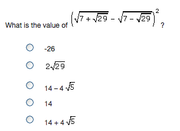What is the value of [√(7+√29) - √(7-√29)]²?
-26
2√29
14-4√5
14
14+4√5
The square of a value must be nonnegative.
Eliminate A.
Rather than calculate, BALLPARK:
[√(7+√29) - √(7-√29)]²
≈ [√(7 + 5.5) - √(7 - 5.5)]²
= [√(12.5) - √(1.5)]²
≈ [3.5 - 1]²
≈ (5/2)²
= 25/4
≈ 6.
The correct answer choice must be close to 6.
B, D and E are all too big.
The correct answer is
C.
Algebraic approach:
Let x=7 and y=√29.
Substituting x=7 and y=√29 into [√(7+√29) - √(7-√29)]², we get:
( √(x+y) - √(x-y) )²
= (x+y) + (x-y) - 2√((x+y)(x-y))
= 2x - 2√(x²-y²).
Substituting x=7 and y=√29 back into the resulting expression, we get:
= 2*7 - 2√(7² - 29)
= 14 - 2√20
= 14 - 4√5.
The correct answer is
C.
Private tutor exclusively for the GMAT and GRE, with over 20 years of experience.
Followed here and elsewhere by over 1900 test-takers.
I have worked with students based in the US, Australia, Taiwan, China, Tajikistan, Kuwait, Saudi Arabia -- a long list of countries.
My students have been admitted to HBS, CBS, Tuck, Yale, Stern, Fuqua -- a long list of top programs.
As a tutor, I don't simply teach you how I would approach problems.
I unlock the best way for YOU to solve problems.
For more information, please email me (Mitch Hunt) at
[email protected].
Student Review #1
Student Review #2
Student Review #3